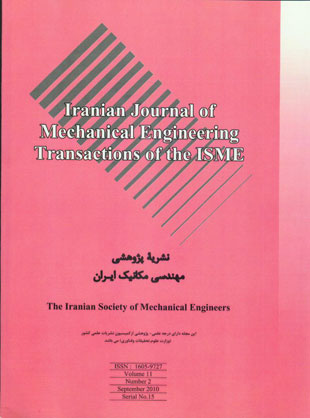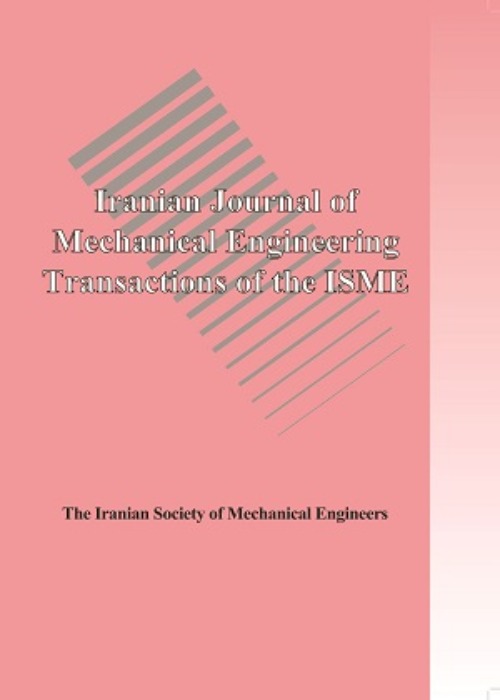فهرست مطالب

Iranian Journal of Mechanical Engineering Transactions of ISME
Volume:11 Issue: 2, Sept 2010
- 80 صفحه،
- تاریخ انتشار: 1391/01/10
- تعداد عناوین: 5
-
-
Instruction for the preparation of Camera - Ready PapersPages 1-4
-
Pages 5-14During the past two decades, there have been tremendous developments in near-field imaging and local probing techniques. Examples are the Scanning Tunneling Microscope (STM), Atomic Force Microscope (AFM), Near-field Scanning Optical Microscope (NSOM), Photon Scanning Tunneling Microscope (PSTM), and Scanning Thermal Microscope (SThM).Results showed that the average reflectance for a dopant concentration of 1018cm−3 is 0.28247 in 25ºC, 0.30064 in 500ºC and 0.32052 in 1000ºC for donors. The average reflectance for a dopant concentration of 1018cm−3 is 0.282474 in 25ºC, 0.30064 in 500ºC and 0.32052 in 1000ºC for acceptors. For visible wavelengths, more reflectance occurs in greater temperature and the emittance decreases as the temperature increases. In these wavelengths, transmittance is negligible. At room temperature for concentration less than 1019cm−3, concentration has not important influence on radiative properties. At room temperature, the scattering process is dominated by lattice scattering for lightly doped silicon, and the impurity scattering becomes important for heavily doped silicon when the dopant concentration exceeds 1018cm−3.Keywords: Temperature, Radiative Properties, Nanoscale, Multilayer, Coherent Formulation, Visible Wavelengths
-
Pages 15-38Based on the differential transformation method, a semianalytical solution is developed for free vibration and modal stress analyses of variable thickness two-directional functionally graded circular plates with restrained edges, resting on elastic foundations. Variations of the material and geometry parameters are monitored by five distinct exponential functions. The presented non-dimensional solution covers complex combinations of the material properties, edge conditions, and parameters of the elastic foundation. Results reveal that by a proper adoption of the distribution of the material properties, a somewhat uniform strength may be attained for the cross sections without the need to change the geometric parameters of the plate.Keywords: differential transform, vibration, modal stress, circular plate, two, directional functionally graded materials, elastic foundation
-
Pages 39-65The thermomechanical buckling of simply supported thin shallow spherical shells made of functionally graded material is presented in this paper. A metal-ceramic functionally graded shell with a power law distribution for volume fraction is considered, where its properties vary gradually through the shell thickness direction from pure metal on the inner surface to pure ceramic on the outer surface. The mechanical properties of the metal and ceramic are assumed to be temperature dependent. The governing equations are derived using the first-order shell theory of Love and Kirchhoff, the Donnell-Mushtari-Vlasov kinematics equations, and the calculus of variations. The analytical results are obtained for various types of loadings. The detailed results are compared and validated with the known data in the literature.Keywords: buckling, shallow spherical shell, FGM, temperature, dependent material
-
Pages 66-80Based on the recently introduced fractional Taylor’s formula, a fractional heat conduction constitutive equation is formulated by expanding the single-phase lag model using the fractional Taylor’s formula. Combining with the energy balance equation, the derived fractional heat conduction equation has been shown to be capable of modeling diffusion-to-Thermal wave behavior of heat propagation by changing the order of fractional differentiation. Finally, finite sine-Fourier and Laplace transforms are employed to find the exact solution of a signaling problem.Keywords: Fractional calculus, Non, Fourier heat conduction, Generalized Taylor's Formula Diffusion, to, Thermal wave propagation, Exact solution


